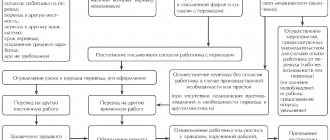In accordance with the requirements of Federal Law No. 79 of July 27, 2004, the procedure for maintaining personal files of employees is provided for government agencies and applies to all employees and officials. This obligation does not apply to other organizations (commercial and non-profit organizations). All legal entities and individual entrepreneurs have the opportunity not to conduct them or to conduct them at their own discretion. Since generated personal files (PD) make it possible to best systematize the organization’s personnel data and give HR officers the opportunity to quickly find any necessary information, in practice they are maintained by almost all companies. It is more convenient to do this in accordance with existing recommendations.
General requirements for the cover of a personal file
On the first page of your personal file you must provide information that allows you to clearly identify:
- its belonging to a certain nomenclature group;
- its content;
- shelf life.
There is no legislative regulation of the registration procedure , but in practice we recommend using the rules given in the order of the Ministry of Culture of Russia dated March 31, 2015 No. 526.
Thus, the title page of a personal file must include (clauses 4.25, 4.28, 4.29 of Appendix No. 28 to Order No. 526):
- The full name of the organization is in the nominative case.
- Division name.
- Case registration number or index.
- Volume serial number – if it includes several folders.
- Name of the case - as a rule, full name is indicated in this line. employee.
- The start date of the case, and for dismissed employees - the end date of the case.
- Shelf life.
- A code that allows you to identify the location where the case is stored in the archive.
- Number of sheets in file.
If during the existence of the company it was reorganized and changed its name, when re-registering the title page, the new name of the organization is indicated on it, and the old one is placed in brackets.
The case registration number is duplicated on the spine of the folder.
On the back of the title page of the personal file, you can place an inventory of the documents included in it.
The data can either be entered by hand directly into the prepared form, or filled out on a computer, printed and pasted on the first page of the folder.
Is it necessary to keep personal files of employees?
Maintaining personal files of employees is not mandatory for all employers.
Thus, it is mandatory to open personal files for civil servants. This is the requirement of the Law “On State Civil Service in the Russian Federation” dated July 27, 2004 No. 79-FZ. They contain personal data and other information related to entry into the civil service, its passage and dismissal from it, as well as information necessary to ensure the activities of the relevant government agency. As for commercial organizations (namely, we will talk about them further), they do not have a corresponding obligation. They can conduct personal affairs of staff on their own initiative. In practice, companies do just that. This allows you to systematize and streamline personnel document flow, and also helps you quickly find the necessary information about an employee at the right time. We will tell you below what requirements need to be met so that you don’t have to pay for all these amenities.
Sample of filling out the title page
The procedure for filling out the title page, as well as its form, is not regulated. Therefore, if you need to indicate other information, you can enter additional fields and blocks in the form given above.
The company has the right to develop its own format for the cover of a personal file and approve it by order of the head of the company.
Below is a typical completed sample cover page of the personal file of an employee of a commercial company.
Read also
23.10.2020
Composition of an employee's personal file in 2020-2021
We probably all imagine a personal file in the form of a folder or file containing a certain set of documents about the employee and his work and their copies. As a rule, this is true. What should be in an employee's personal file? The employer determines its composition based on his own ideas and needs. Since managing personal affairs is a right, not an obligation, the procedure for their registration is established in each specific company. It is advisable to consolidate it in a local regulatory act.
Typically the list of documents in an employee’s personal file is as follows:
- application form to be filled out when applying for a job;
The employee application form for your personal file can be downloaded here.
- employment contract;
- job description;
- copies of employee orders.
IMPORTANT! Personal cards in the T-2 form do not need to be included in personal files. They are stored separately.
Now attention! Very often, copies of documents provided by the employee during employment are filed in the personal file: passport, SNILS document, TIN certificate, diplomas, etc. All these documents contain the person’s personal data. Therefore, it is impossible to store them just like that (so that they exist). At a minimum, you must obtain consent from the employee to process personal data indicating the specific purpose for which it will be used. At least Rostrud allows you to do this. But it’s better to stop collecting copies of personal documents altogether. We received the documents, recorded all the information necessary to formalize the employment relationship and returned everything to the employee. This will eliminate the risk of claims during inspections.
And of course, you should not keep copies of documents for dismissed employees. The Law “On Personal Data” dated July 27, 2006 No. 152-FZ allows the storage of personal data no longer than required by the purposes of their processing. And with the dismissal of an employee, the corresponding goal is lost.
IMPORTANT! For violations in working with personal data, Art. 13.11 of the Code of Administrative Offenses provides for quite significant fines. Roskomnadzor conducts checks of compliance with personal data legislation.
See also: “Photo pass may result in personal information fine.”
And by the way, keep in mind that personal files themselves also belong to personal data. Therefore, when working with them, you must act strictly within the framework of the law.
Find out more about the rules for working with personal data from the materials in our section of the same name.
Internal inventory
Simultaneously with the formation of the case, an internal inventory is drawn up, which is compiled to record documents of permanent and temporary (over 10 years) storage. The inventory is compiled according to the form given in Appendix 10 of the Basic Rules for the Operation of Archives of Organizations, and is filled out throughout the entire period of its maintenance.
What are we talking about?
The legislation states that the concept of “deed” means a special way of drawing up a document or a set of documents related to one issue or area of activity. In accordance with sub. 95 clause 3.2.2 GOST R 7.0.8-2013, these are documents placed in a separate cover (folder). There are no special regulations for maintaining (there are only for state and municipal employees). But if the company decides to conduct personal affairs, it will have to approve the corresponding regulations on the management of personal affairs of employees and regulate this process at the enterprise level. This internal regulation defines:
- what papers will be stored (composition) and for what purpose;
- order of conduct;
- list of employees for whom LD will be issued;
- procedure for access to information;
- terms and storage conditions;
- features of archiving or destruction after dismissal.
In addition, the company appoints an employee who is responsible for this process.
Maintenance rules and storage periods
Documents that have different shelf life are usually placed in LD. Personnel officers should be guided by the order of the Ministry of Culture of Russia dated August 25, 2010 No. 558, which established all the storage periods for documents. It should be remembered that many personnel documents are stored for a long time (over 10 years), and if they are included in the LD, then the storage period for employees’ personal files is no less than this period. Typically, such documents as part of the LD must be stored for at least 50 years (Article 22.1 of the Federal Law of October 22, 2004 No. 125 (as amended on December 28, 2017) “On Archival Affairs in the Russian Federation”).
The procedure for maintaining LD is determined at the company level. Usually all papers are placed in it in chronological order. And so that nothing is lost, an inventory is sewn in, which is maintained all the time, and a certificate is filled out about the composition of the documents included in the employee’s personal file. The inventory form is developed independently or a sample is used for government agencies.
How long to store
Such a dossier is a long-term storage document. Therefore, there is no need to file documents with a shelf life of less than 5 years (applications and orders for vacation, time off, certificates from place of residence, health status, etc.).
It is prohibited to receive, process and attach to a personal file personal data not established by the Federal Law on political, religious and other beliefs, private life, membership in public associations, including trade unions. It is also prohibited to store originals of diplomas, military IDs, work records, etc.
It should be noted that in relation to civil servants, the inclusion and storage of copies of personal documents in their personal files is provided for by regulation (clause 16 of the “Regulations on the personal data of a state civil servant of the Russian Federation and the management of his personal file”, approved by Decree of the President of the Russian Federation of May 30, 2005 No. 609 ). In relation to other categories of employees (commercial, budgetary organizations), the processing of personal data can be carried out within the framework of predetermined, legitimate purposes and is limited to their achievement (Part 2 of Article 5 of the Federal Law of July 27, 2006 No. 152-FZ “On Personal Data”). That is, in order to store copies of personal documents, the Instructions for working with personal files must record a list of them and justify the purposes of their storage.
What documents should be
The employer usually has at his disposal both the originals of employee documents (forms, registration cards) and their copies. Both of them get into LD. It should be remembered that copies of documents must be certified in the prescribed manner in the proper manner (for state employees, copies of passports are mandatory in the LD, for other categories of employees this issue is resolved at the company level). Answering the question of what documents are included in the employee’s personal file in 2021, we note that they are divided into:
- formed at the time a person gets a job;
- arising in the course of work in the company;
- documents on dismissal from a specific company.
The first group includes:
- resume compiled by the applicant for the vacancy;
- employee questionnaire form for personal file (free form is used);
- application for a job;
- reference from a previous place of work or recommendations (if any);
- copies of documents with the personal data of an individual (passports, INN, SNILS, military ID cards (for those who have served and those who are still subject to conscription into the army), diplomas);
- a certificate of the presence (absence) of a criminal record (when applying for a job, the implementation of which is not allowed for persons with a criminal record or who have been subject to criminal prosecution);
- certificate of completion of a medical examination (for employment in cases provided for by the Labor Code of the Russian Federation) and a medical book;
- employment contract (employer's original);
- The order of acceptance to work.
The second group will contain personal documents for the employee’s children (necessary for paying benefits, assigning vacations and providing deductions for personal income tax), an agreement on financial responsibility, a copy of the job description, additional agreements to the employment contract (if concluded), orders for transfers, appointments , incentives or penalties. This includes information about undergoing periodic medical examinations, information about advanced training or training, and a signature on non-disclosure of trade secrets. Here, if necessary, the following are stored:
- copies of applications and orders for granting leave;
- explanatory notes;
- office notes;
- various acts and notifications.
The third and final group includes the employee’s statement and the organization’s order for dismissal.
Features of compilation
In all areas, both commercial and budgetary, personal files are maintained for all employees without exception. In some cases, the organization provides for selective maintenance of LD. That is, for certain employees. For example, only those responsible financially or heads of departments.
Employees of the HR department prepare, maintain and store documentation. This responsibility is assigned to them by the manager with the appropriate order.
The list of employees who are allowed access to the LD is required for approval. Such employees are authorized to familiarize themselves with the contents of the document, receive the file in their hands, in order to perform any work.
Changes in personal files are recorded as they occur. To do this, you do not need to wait for an order from management, as for other internal documents. Since a personal file is a kind of “repository” of chronological information, all changes are applied in the usual manner, but included in the inventory.
LDs begin to be formed after a person is hired. The first documents placed in the folder are personal information - questionnaires. After creating the document, the folder must be stitched and registered.
An integral part of the folder is the certification sheet. It is created separately. A sheet is needed to number the documentation included in the case. On the certification sheet, the condition of the pages is recorded, and the specifics for filling out individual sheets are prescribed.
Normative base
First of all, a local regulatory act (regulations or instructions for maintaining personal records) should be developed, which prescribes the rules and requirements for the design, content, maintenance, storage of personal files, etc.
When compiling an employee’s personal file, the requirements for its registration are regulated by the following regulations:
- Labor Code of the Russian Federation (Chapter 14).
- Federal Law of July 27, 2006 No. 152 “On Personal Data”.
- Federal Law of October 22, 2004 No. 125 “On archiving in the Russian Federation.”
- “Basic rules for the work of archives of organizations”, approved by the decision of the Board of Rosarkhiv dated 02/06/2002.
- GOST R 6.30-2003, adopted by Decree of the State Standard of the Russian Federation dated 03.03.2003 No. 65-st (from 01.07.2018 ceases to be valid due to the introduction of the National Standard of the Russian Federation GOST R 7.0.97-2016, approved by Order of Rosstandart dated 25.05.2017 No. 435 -st).
- Order of the Ministry of Culture of the Russian Federation dated August 25, 2010 No. 558 “On approval of the List of standard management archival documents generated in the course of the activities of state bodies, local governments and organizations, indicating storage periods.”
IMPORTANT!
When working with personal files, it is important to remember that they contain personal data, and compliance with the requirements for their protection is the responsibility of employers. For violation of these provisions, perpetrators may be subject to disciplinary, material, civil, administrative and criminal liability.
You can also refer to the regulatory documents regulating personnel work in this area in government agencies, which can help in the development of LNA:
- Federal Law No. 79 dated July 27, 2004;
- Federal Law of March 2, 2007 No. 25;
- Decree of the President of the Russian Federation dated June 1, 1998 No. 640;
- Decree of the President of the Russian Federation dated May 30, 2005 No. 609.
How to fill out an employee application form
In many organizations or individual entrepreneurs, during interviews, employees are asked to fill out a questionnaire. The questionnaire is designed to give employers an idea of the employee’s qualifications, education, work experience, etc. The application form is usually accompanied by a photograph of the employee. The questionnaire usually contains the following questions:
- about education;
- about human interests;
- about work experience;
- about previous places of work;
- about marital status;
- about the presence or absence of children;
- questions about a person’s gender and age;
- about bad habits;
- about the absence of any diseases (for certain types of work);
- about qualifications;
- about professional skills;
- about professional achievements;
- other information
Instructions for filling
After establishing an employee’s personal file, he must fill out a form. The questionnaire must provide comprehensive answers to all questions.
Laconic and clear answers without unnecessary fluff. After the questionnaire, you should place a photo of the employee. This should be a new photo, and not one where he is 18, when in fact a man of about 40 is standing in front of you. The autobiography must be compiled correctly and reflect all stages of the employee’s life. Educational institutions, interests, places of work and more.
Copies of documents on education or advanced training in certain areas must be certified first. When compiling a personal file, an employee is obliged to promptly report any changes (last name, first name, etc.).
The external characteristics of the employee are signed by the director of the enterprise, and the internal characteristics - by the head of the division or department of the company. All pages must be numbered.
Who do they file personal files against?
This question can be answered unequivocally only in relation to civil servants: for all, as required by law.
Since maintaining personal files is not necessary for private entrepreneurs, they themselves can decide which employees to keep this documentation for, and which ones can do without such detailed personnel records. Some managers who practice this system prefer to keep personal records for all personnel in order to systematize data for each employee. But some, in order to save time, organize the management of personal files only for certain categories of employees.
For employees of what positions are personal files usually opened?:
- management;
- deputy managers at various levels;
- key specialists;
- employees bearing financial responsibility;
- personnel reserve, etc.
FOR YOUR INFORMATION! It is advisable to open a personal file for such employees, regardless of the form and time of his employment - he works part-time or at his main job, under a fixed-term employment contract or on a permanent basis.
Less often, positions are provided with personal records for which educational, qualification or other special requirements are not provided, for example, cleaner, watchman, janitor, etc.
Formation of an employee’s personal file: sample 2020-2021
When organizational issues and legal issues regarding personal matters have been resolved, all that remains is to compile and formalize them. Typically the order is as follows:
- A separate folder (or file) is created for each employee.
- Documents in the personal file are filed in chronological order as they are received, starting with admission documents (application, employment contract, admission order) and ending with a copy of the dismissal order.
- Each sheet of the case is numbered.
- No more than 250 sheets are filed in one volume (clause 4.20 of the rules for organizing the storage, acquisition, recording and use of documents of the Archive Fund of the Russian Federation, approved by order of the Ministry of Culture dated March 31, 2015 No. 526), if more documents have accumulated, a new volume is opened.
- Each incoming document is recorded in the internal inventory of the case.
A sample list of documents in a personal file and recommendations for its preparation can be found here.
The cases themselves are numbered and registered in the employee personal affairs journal (the form of the journal can be developed independently).
See also: “Nomenclature of HR Department Affairs.”
What documents will Trudoviks require in the event of an inspection? How to prepare them correctly and how long should they be stored? You will find answers to these and other questions in the Guide to Personnel Issues from ConsultantPlus. If you do not have access to the K+ system, get a trial online access for free.







